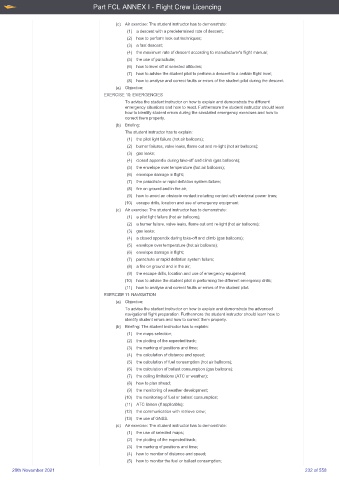Page 232 - UK Aircrew Regulations (Consolidated) 201121
P. 232
Part FCL ANNEX I - Flight Crew Licencing
(c) Air exercise: The student instructor has to demonstrate:
(1) a descent with a predetermined rate of descent;
(2) how to perform look out techniques;
(3) a fast descent;
(4) the maximum rate of descent according to manufacturer's flight manual;
(5) the use of parachute;
(6) how to level off at selected altitudes;
(7) how to advise the student pilot to perform a descent to a certain flight level;
(8) how to analyse and correct faults or errors of the student pilot during the descent.
(a) Objective:
EXERCISE 10: EMERGENCIES
To advise the student instructor on how to explain and demonstrate the different
emergency situations and how to react. Furthermore the student instructor should learn
how to identify student errors during the simulated emergency exercises and how to
correct them properly.
(b) Briefing:
The student instructor has to explain:
(1) the pilot light failure (hot air balloons);
(2) burner failures, valve leaks, flame out and re-light (hot air balloons);
(3) gas leaks;
(4) closed appendix during take-off and climb (gas balloons);
(5) the envelope over temperature (hot air balloons);
(6) envelope damage in flight;
(7) the parachute or rapid deflation system failure;
(8) fire on ground and in the air;
(9) how to avoid an obstacle contact including contact with electrical power lines;
(10) escape drills, location and use of emergency equipment.
(c) Air exercise: The student instructor has to demonstrate:
(1) a pilot light failure (hot air balloons);
(2) a burner failure, valve leaks, flame out and re-light (hot air balloons);
(3) gas leaks;
(4) a closed appendix during take-off and climb (gas balloons);
(5) envelope over temperature (hot air balloons);
(6) envelope damage in flight;
(7) parachute or rapid deflation system failure;
(8) a fire on ground and in the air;
(9) the escape drills, location and use of emergency equipment;
(10) how to advise the student pilot in performing the different emergency drills;
(11) how to analyse and correct faults or errors of the student pilot.
EXERCISE 11: NAVIGATION
(a) Objective:
To advise the student instructor on how to explain and demonstrate the advanced
navigational flight preparation. Furthermore the student instructor should learn how to
identify student errors and how to correct them properly.
(b) Briefing: The student instructor has to explain:
(1) the maps selection;
(2) the plotting of the expected track;
(3) the marking of positions and time;
(4) the calculation of distance and speed;
(5) the calculation of fuel consumption (hot air balloons);
(6) the calculation of ballast consumption (gas balloons);
(7) the ceiling limitations (ATC or weather);
(8) how to plan ahead;
(9) the monitoring of weather development;
(10) the monitoring of fuel or ballast consumption;
(11) ATC liaison (if applicable);
(12) the communication with retrieve crew;
(13) the use of GNSS.
(c) Air exercise: The student instructor has to demonstrate:
(1) the use of selected maps;
(2) the plotting of the expected track;
(3) the marking of positions and time;
(4) how to monitor of distance and speed;
(5) how to monitor the fuel or ballast consumption;
20th November 2021 232 of 558

